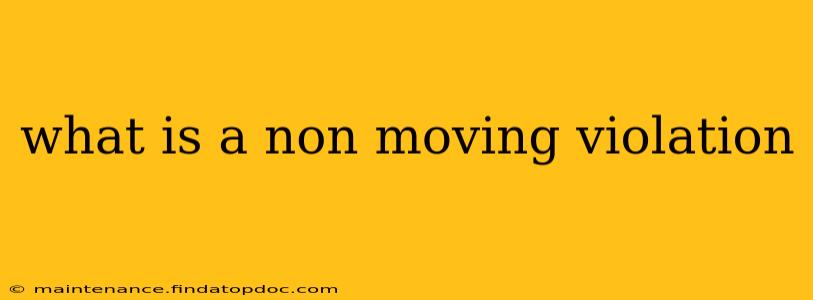What is a Non-Moving Violation?
A non-moving violation, also known as a stationary violation, is a traffic infraction that occurs while a vehicle is not in motion. This contrasts with moving violations, which happen while the vehicle is operating and driving. These violations typically involve parking, standing, or other regulatory issues related to a vehicle's position rather than its operation.
Understanding the difference between moving and non-moving violations is crucial because the consequences can vary significantly. Moving violations often carry more severe penalties, including higher fines, points on your driving record, and even license suspension. Non-moving violations, while still infractions, generally result in less stringent consequences.
What are some examples of Non-Moving Violations?
Many common traffic infractions fall under the category of non-moving violations. These include, but aren't limited to:
- Expired registration: Failing to renew your vehicle's registration tags.
- Expired inspection sticker: Driving with an expired vehicle inspection sticker (required in many states).
- Parking violations: This is a broad category encompassing numerous offenses such as parking in a no-parking zone, exceeding the time limit in a metered space, blocking a driveway or fire hydrant, or parking illegally in handicapped spots.
- Equipment violations: Driving with faulty headlights, broken taillights, or other non-functional equipment. (Sometimes these can be moving violations depending on the severity and circumstances)
- Defective tires: Operating a vehicle with bald or severely damaged tires.
- Improper window tinting: Exceeding the legal limit of window tint darkness.
- Failure to display license plate: Not properly displaying your license plates.
- Overweight vehicle: Exceeding the weight limit for the vehicle or roadway.
How are Non-Moving Violations handled?
Typically, non-moving violations are handled through a citation left on your vehicle or a mailed notice. You'll usually have a specified period to pay the fine, contest the citation in court, or attend traffic school (depending on your location and the specific violation). The process is generally less involved than addressing a moving violation.
What are the penalties for Non-Moving Violations?
Penalties for non-moving violations are usually less severe than moving violations. They generally involve fines, but they rarely result in points on your driving record or license suspension. However, accumulating multiple non-moving violations could potentially lead to further consequences.
Are Non-Moving Violations reported to insurance companies?
This depends on the state and the specific insurance company. While many non-moving violations are not reported and don't affect insurance premiums, some insurers might consider a pattern of violations when assessing risk. It's always best to check with your insurance provider to understand their specific policy.
Can a Non-Moving Violation affect my driving record?
Generally, no. Non-moving violations typically do not result in points on your driving record, unlike moving violations which often do. However, the accumulation of a significant number of non-moving violations over a period might impact your insurance rates.
What should I do if I receive a Non-Moving Violation?
Carefully review the citation to understand the violation and the deadline for payment or contesting the ticket. If you believe the citation is incorrect, you have the right to contest it in court. It's essential to respond to the citation within the stipulated timeframe to avoid further penalties.
By understanding the nature and consequences of non-moving violations, you can be better prepared to manage any such infractions and maintain a clean driving record. Remember to always check your local traffic laws and regulations for specific details.
